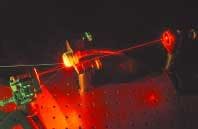Red VECSELs emit 400 mW
New research, due to be reported by a European group, provides what the researchers believe is the first demonstration of high-power continuous-wave (CW) operation from a red vertical-external-cavity surface-emitting laser (VECSEL). The researchers, from the Institute of Photonics at the University of Strathclyde (Glasgow, Scotland) and the Finnish Optoelectronics Research Centre (Tampere, Finland), have seen CW powers of up to 400 mW at 674 nm from a gallium indium phosphide/aluminum gallium indium phosphide (GaInP/AlGaInP) VECSEL in a three-mirror cavity arrangement. The same system has also been demonstrated as a monolithic microchip VECSEL.
null
In the semiconductor-laser arena, vertical-cavity surface-emitting lasers (VCSELs) have been around for some time, and more recently optically pumped VECSELs have demonstrated good performance in the IR. They offer a higher power output with excellent mode quality. The external cavity provides robust mode control, and also allows for intracavity frequency doubling to access blue regions of the spectrum. Modelocking and single-frequency operation have been demonstrated, and VECSELs are seen as a possible replacement for gas lasers in many research and industrial applications. But developing VECSELs that emit directly in the visible region has proved challenging; the region is outside the comfortable limits of the aluminum indium gallium arsenide (AlInGaAs) material system and there is currently no suitable semiconductor diode pump available. But with the advent of multiwatt gallium nitride-based blue and violet laser diodes, several groups have started developing AlGaInP VECSELs that could use these blue diodes as a pump source.
The Scottish group, headed by Jennifer Hastie and Martin Dawson, used a frequency-doubled Nd:YVO4 (vanadate) laser at 532 nm to pump a VECSEL based on GaInP/AlGaInP. The VECSEL structure was grown on a 2-in.-diameter GaAs substrate by molecular-beam epitaxy and consists of a distributed Bragg reflector for high reflectivity at the signal wavelength and a multi-quantum-well gain region. The resonant-periodic-gain (RPG) wavelength, which determines the output wavelength of the VECSEL, was set at 670 nm. The quantum wells were 6 nm thick to achieve a room-temperature peak emission wavelength at 660 nm. The offset between the quantum-well and RPG wavelengths, which shift at different rates with temperature, was set to optimize performance at the operating temperature.
The system was first demonstrated by cleaving a 4 × 4-mm sample from the VECSEL wafer and bonding it to a 4 × 4‑mm, 250-µm-thick single-crystal diamond plate, which acts as an intracavity heat spreader for the VECSEL wafer. The sample and heat spreader were clamped in a brass water-cooled mount and optically pumped with up to 3.5 W at 532 nm in a 75-µm-diameter focus. The VECSEL cavity is folded (see figure). With the VECSEL sample mount cooled to 0°C, 390-mW output power was achieved with a slope efficiency of 17% and a central wavelength around 674 nm. The output beam was close to TEM00.
The VECSEL concept was also tried using the same material but in a microchip format. An external cavity formed by air-spaced bulk optical elements has a length of several centimetres. Monolithic microchip VECSELs, where the cavity is formed between the VECSEL semiconductor back mirror and a dielectric mirror coating on the outer surface of the heat spreader, offer highly compact lasers with a cavity mode volume of less than 1 mm3. The technique also offers a route to low-cost mass production of the devices. In order to demonstrate the viability of a red microchip VECEL, the group used the same-sized sample from a GaInP/AlGaInP VECSEL structure on its GaAs substrate. It was bonded to a similar single-crystal polished disk of natural diamond, but in this case the diamond plate was commercially dielectric-coated for greater than 95% transmission at the pump wavelength and 99% reflectivity at the signal wavelength. The diamond then acted as both heat spreader and output coupler. Using the same pump laser, and with the VECSEL-mount cooling water set at −5°C, 330 mW of CW output power was achieved, again with a quasi-Gaussian output mode. The peak wavelength of the output in this configuration was 676 nm.
“We are working on further refinements, including microlenses for cavity-mode control and compact fiber coupling, and operating the system at a range of wavelengths from 635 to 670 nm,” said Hastie. “With these systems, a range of applications can be targeted, some with single-frequency operation and perhaps frequency doubling to UV wavelengths.”


